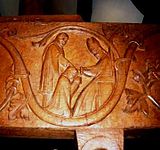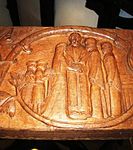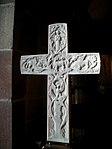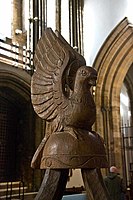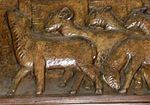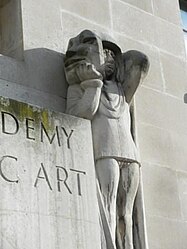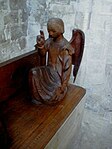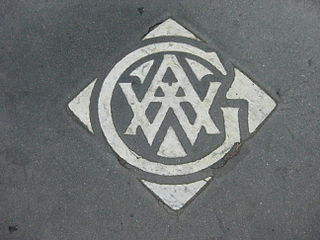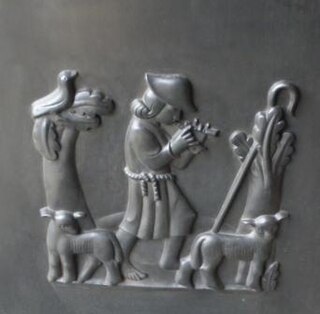| Work | Location | Notes and References |
|---|
| Acrobats | Tate Britain | The carving, made of walnut, was shown at Leicester Galleries Exhibition in 1930. [26] [27] |
| African fruit-seller | Bradford 1 Gallery in Centenary Square, Bradford. [8] | The stone sculpture was shown at Leicester Galleries Exhibition in 1930. [28] |
| Archer | Unknown | A cedarwood carving. [29] |
| Carvings for RMS Queen Mary | Longbeach, California. | Durst carved "Struggle", "Cat" and "Hind and Young", all three in stone, and "Horse" carved from Sienna marble. |
| Creation (tondo) | Unknown | The stone sculpture was shown at Leicester Galleries in 1930. [30] |
| Dancer | Unknown | Wood carving. Exhibited at British Handicrafts by the Arts and Crafts Society and the Red Rose Guild, 1940. [31] |
| Diana | Unknown | Torso carved in oak and shown Leicester Galleries Exhibition in 1930. [32] |
| Dog | Unknown | Sienna marble carving. Exhibited at British Handicrafts by the Arts and Crafts Society and the Red Rose Guild, 1940. [33] |
| Dog with bone | Unknown | Carving in sandstone [34] |
| Eve and Cain | Unknown | Stone sculpture shown at Leicester Galleries Exhibition in 1930. [35] |
| Feline | Tate Britain | Work in Sienna marble shown at Leicester Galleries in 1930. [36] [37] Held by Tate Britain and presented to the Tate by the executors of Mrs. Herbert Gibson in 1932. Mrs Gibson had purchased the piece from Leicester Galleries having seen it at their 1930 Exhibition. [8] |
| Female figure | Unknown | Stone sculpture shown at Leicester Galleries Exhibition in 1930. [38] |
| Female figure | Unknown | Sculpture shown in 1930 at Leicester Galleries. [39] |
| Girl Binding Her Hair | Unknown | Wood carving shown at The Royal Glasgow Institute of the Fine Arts Eighty-Second Annual Exhibition, 1943. [40] |
| Girl binding her hair | Tate Britain | The Derbyshire fossil stone sculpture standing on a black marble base was shown in 1930 at Leicester Galleries Exhibition. This work is held by Tate Britain, presented to them in 1965 by the Trustees of the Chantrey Bequest. [41] [42] |
| Goat | Unknown | Stone sculpture shown at Memorial Exhibition of Sculpture by the late Henry Poole, RA at the Leicester Galleries. [43] |
| Head of girl | Unknown | Work in marble. Exhibited at The Exhibition of The Royal Scottish Academy of Painting, Sculpture and Architecture, The One-Hundred-and-Third, 1929. [44] |
| Horse | Installed on R.M.S."Queen Mary". | Stone sculpture. [45] |
| Horse | Unknown | Carving in rouge sanguine. Exhibited at The Exhibition of The Royal Scottish Academy of Painting, Sculpture and Architecture, The One-Hundred-and-Third, 1929. [46] |
| Household God | Unknown | Carving in birchwood shown at Leicester Galleries in 1930. [47] |
| Job | Unknown | The stone sculpture was shown at Leicester Galleries Exhibition in 1930. [48] |
| Man and Lion | Unknown | The sculpture was shown in 1930 at Leicester Galleries. [49] |
| Maritime Museum at Greenwich | Greenwich, Outer London | Durst carried out carvings from oak of the head of a sailor and a marine. It was acquired by the War Artists’ Committee in 1944. [8] |
| Mask | Unknown | Carving in teak shown at Leicester Galleries in 1930. [50] |
| Mask | Unknown | Stone carving exhibited at Leicester Galleries in 1930. [51] |
| Oak Carving | Unknown | Carving made from the "Headingly Shire Oak". Durst was apparently sent a piece of the tree for carving. [52] |
| Pieta | Manchester Art Gallery | Marble work shown at Leicester Galleries in 1930. [53] Held in the collections of the Manchester Art Gallery, though not currently on display. [8] |
| Prehistoric Man | Unknown | The ivory carving was shown at Leicester Galleries in 1930. [54] |
| Sea Lions | Docklands, Outer London | Durst carved a fountain sculpture featuring sea lions. This was commissioned in 1960 by the London County Council for an old peoples home in Greenlaw Street in the Docklands area. [8] |
| Seated Figure | Unknown | Work in Greek marble shown at Leicester Galleries in 1930. [55] |
| Seated Torso | Unknown | The stone sculpture was shown at 1930 Exhibition at Leicester Galleries. [56] |
| Sleeping faun | Unknown | Marble carving. Exhibited at The Exhibition of The Royal Scottish Academy of Painting, Sculpture and Architecture, The One-Hundred-and-Third, 1929. [57] |
| Sleeping woman | Unknown | Stone sculpture. Shown at Leicester Galleries in 1930. [58] |
| Standing figure | Unknown | Stone sculpture. Exhibited at The Exhibition of The Royal Scottish Academy of Painting, Sculpture and Architecture, The One-Hundred-and-Third, 1929. [59] |
| Tree spirit | Unknown | Carving in mahogany shown at Leicester Galleries Exhibition of 1930. [60] |
| Tumbler (female) | Unknown | Carving in jarrah (eucalyptus). [61] |
| Tumbler (male) | Unknown | The carving in jarrah (eucalyptus) was shown at Leicester Galleries in 1930. [62] |
| Venus and Cupid | Unknown | Stone sculpture. [63] |
| Woman | Unknown | Sculpture in African grey stone. Exhibited at The Exhibition of The Royal Scottish Academy of Painting, Sculpture and Architecture, The One-Hundred-and-Third, 1929. [64] |


